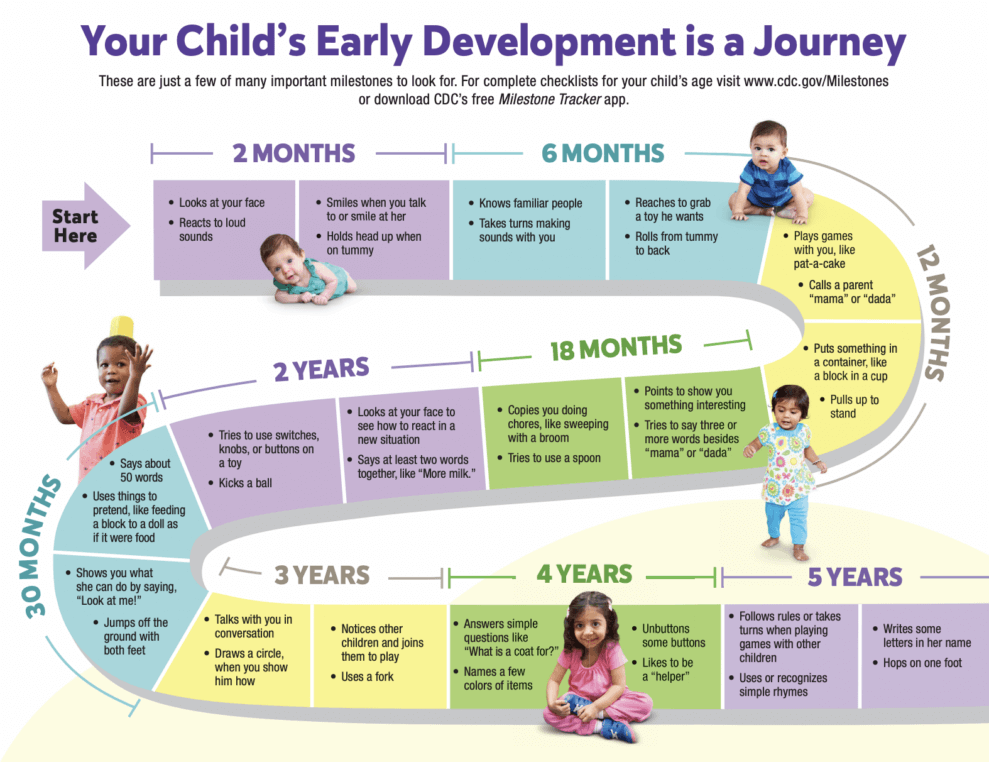
The CDC’s revised developmental milestones: What parents need to know
Watching your baby grow and change is one of the most exciting parts of being a parent. From wondrous first smiles (aww) to rolling over and tentative wobbly steps, there’s a lot happening as their bodies develop and their minds make new discoveries.
Shared in family chat groups and recounted proudly at the playground, each new movement, social-emotional, learning, and language milestone can be a source of joy. But sometimes, little ones just aren’t all that keen on holding up their head during tummy time, or show no interest in taking those first steps. For brand-new parents and even been-there-done-that veterans, these major achievements—called developmental milestones—and when they should happen can be downright confusing, and even worrisome.
To help parents and caregivers make sense of developmental guidelines and help them easily track their child’s milestones, the Centers for Disease Control and Prevention (CDC) recently updated its Learn the Signs. Act Early program for children from birth to five years old.
The revised program comes almost 20 years after its initial launch, when the initiative first introduced free developmental milestone checklists, messaging to address concerns, tips and activities, and warning signs of developmental delays.
These new revisions are meant to update key guidelines that had been mainly based on clinical opinions, rather than evidence-based research. The CDC funded the American Academy of Pediatrics (AAP) to assemble a team of experts in child development—including developmental-behavioural, neurodevelopmental, and general pediatricians, as well as child and developmental psychologists. Their goal: to identify evidence-informed milestones, and explain when most children can be expected to reach a milestone (to discourage a wait-and-see approach).
The resulting guidelines are easier to understand and aim to improve early identification of children with autism and those at risk for developmental delays and disabilities, while supporting caregivers and doctors in early interventions.
Changes to the guidelines include:
- The addition of 15- and 30-month milestone checklists so that there’s now a checklist for every well-child visit from two months to five years of age;
- Moving half of the milestones for one-, two-, and three-year-olds to the new 15- and 30-month checklists;
- Removing vague and confusing language like “may” or “begins” when referring to certain milestones;
- Removing milestones that were duplicated across different age checklists;
- Providing new, open-ended questions to use in discussion with families (e.g., Is there anything that your child does or does not do that concerns you?);
- Removing crawling as a milestone;
- Moving walking without holding onto anyone or anything to 18 months, versus the original 12 months;
- Moving speech and language milestones to older ages (a 50-word vocabulary for a 30-month-old where it was previously a milestone at 24 months);
- Expanding tips and activities to support children’s development.
Enjoying this article? Have a little one under the age of four?
Dr. Paul Lipkin, a member of the AAP Section on Developmental and Behavioral Pediatrics and Council on Children with Disabilities, assisted with the revisions. “The earlier a child is identified with a developmental delay the better, as treatment as well as learning interventions can begin,” Dr. Lipkin said in a CDC news release announcing the revisions. “Review of a child’s development with these milestones also opens up a continuous dialogue between a parent and the health care provider about their child’s present and future development.”

Fewer milestones for children
A major change is the removal of more than half of the milestones from the original 216 that were spread across 10 checklists. This includes the removal of duplicates that were confusingly used across multiple ages. Even with the addition of the new 15- and 30-month checklists, there’s now an easier-to-understand 159 milestones across 12 checklists, with the average number of milestones per checklist decreasing from 22 to 13.
Also noteworthy is that 94 of the CDC milestones that were kept moved to a different age. This is based on the updated guidelines that identify when at least 75% or most children should meet each developmental milestone, whereas the previous guidelines used a 50th percentile benchmark, meaning only half of children were expected to achieve the milestone at a given age.
Clinicians reported that following the old guidelines often wasn’t helpful to families who were concerned when their children weren’t meeting the developmental expectations. The new 75th percentile standard is meant to discourage a wait-and-see approach and make it easier to ensure children who need additional screening and resources are properly identified and helped.
The revisions have resulted in mixed reviews from health professionals and associations. The U.S. Autism Society issued a statement supporting the updated guidelines as a way to promote earlier and better screening and diagnosis. The American Speech-Language-Hearing Association (ASHA) took a more cautious approach, publishing a statement in February 2022, noting that they were still evaluating the changes. This was followed up in March with a clarification that while they believe the checklists may facilitate early intervention when used in conjunction with a number of additional clinical tools, the ASHA “remains concerned that some changes in the checklists will slow and/or inhibit referrals for early intervention.”
As well, there has been some pushback and negative feedback on social media from therapists and specialists regarding the removal of crawling from the guidelines.
View the guidelines
To read the updated guidelines, including what developmental milestones most children should reach at each age, tips for promoting your child’s healthy development, and questions to ask your pediatrician, visit the CDC website.
Parents can download the CDC’s free Milestone Tracker App that incorporates the checklists with the aim of helping parents track developments in play, learning, speaking, and movement in children up to five years old. The Milestone Moments Booklet can also be ordered online or downloaded.
The CDC notes that each child is unique and that parents are the ones who know their child the best. Parents needn’t be too concerned if their child hasn’t met all of the milestones listed on time, but should communicate with their child’s doctor to share any concerns they may have. Babies born prematurely (before 37 weeks gestation) have the same milestone as full-term babies, but it’s important to base expectations on their “adjusted” or corrected age.
While the guidelines are currently only for the U.S., it will be interesting to see if similar changes are made in Canada. In the meantime, it’s always best to speak with your pediatrician if you have any concerns about your child’s developmental skills.





